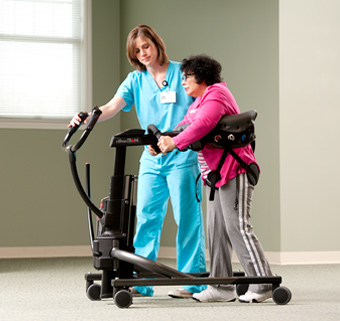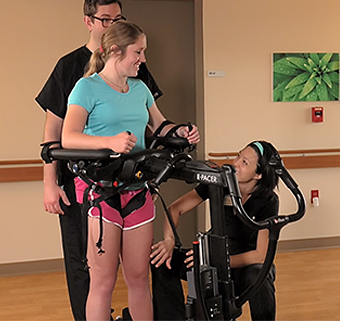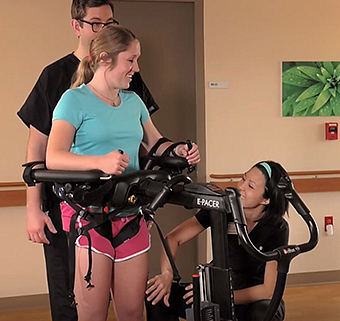Part 1: Understanding the Negative Impact of Prolonged ICU Care
ICU-Acquired Weakness and Post-Intensive Care Syndrome
| October 2020 Part 1 of this sequence will explore both ICUAW and PICS. Part 2 will consider the current concepts of intervention for these conditions.
Part 1 of this sequence will explore both ICUAW and PICS. Part 2 will consider the current concepts of intervention for these conditions.
As the medical field supports the lives of numerous individuals through intervention in intensive care units (ICUs), the surviving patients face significant health challenges. Complications from prolonged ICU care result from immobility, sedation, mechanical ventilation and lengthy hospital stays. These complications are categorized into two increasingly recognized conditions: Intensive Care Unit Acquired Weakness (ICUAW) and Post Intensive Care Syndrome (PICS). Both are serious adverse health events, and their increasing incidence reflects the effects of the COVID-19 pandemic.
Fortunately, current early mobilization interventions and early rehabilitation have the potential to mitigate these conditions. Early mobilization refers to physical activity performed within the first seventy-two hours of a critical illness. The physical activity is at a sufficient level to increase ventilation, circulation, perfusion, muscle metabolism and alertness, as well as decrease rates of venous stasis and deep vein thrombosis.1
Early rehabilitation, on the other hand, includes all physical therapy, occupational therapy and palliative care-related support that is administered within seven days of ICU admission.2 Together, early mobilization and early rehabilitation reduce the risk of developing negative health outcomes during and after ICU stays.
Intensive Care Unit Aquired Weakness
ICUAW is characterized by acute, generalized, symmetrical limb muscle weakness. It is a global condition influencing all domains of the World Health Organization’s International Classification of Functioning, Disability and Health (WHO ICF). ICUAW is related to delayed weaning from mechanical ventilation, extended ICU and hospital stays, more health care-related hospital costs and a higher risk of death at one year after ICU admission.3
Of key interest are recently published reviews that demonstrate a relationship between early rehabilitation and a diminished risk of ICUAW.4 One systematic review found that early mobilization appears to decrease the incidence of ICUAW while at the same time increasing functional capacity and the number of ventilator-free days, and improves discharge-to-home rate.5 Another study found that physical therapy in the ICU improves patients’ quality of life, physical function, peripheral and respiratory muscle strength, ventilator-free days and decreases hospital and ICU stays.6 Similarly, Tipping and colleagues note that active early mobilization and rehabilitation in the ICU improves patients’ mobility status, muscle strength and reduces re-hospitalizations for approximately six months.7 These certainly are encouraging findings.
Post Intensive Care Syndrome
The term Post Intensive Care Syndrome was coined in 2012 to describe new or worsening problems in physical, cognitive or mental health status arising during a critical illness and persisting beyond ICU or hospital discharge.8, 9, 10 This wide-ranging syndrome affects all domains of the World Health Organization’s International Classification of Functioning, Disability and Health (WHO ICF) model. So ICUAW, as described above, belongs to the physical impairments domain of PICS.11
The health events secondary to the COVID-19 pandemic are timely examples of PICS and the concern for early rehabilitation. Many patients returning home after hospitalization for severe respiratory failure confront significant physical, neurological, cognitive and emotional issues.12 This has resulted in an urgent awareness towards addressing the debilitating effects of long term ICU stays.13, 14 And there is world-wide recognition that thousands of COVID-19 patients will need access to intensive rehab services in the future.15, 16
An ICU physical therapy protocol at a COVID-19 center in Brazil, for example, mandates functional training such that before ICU discharge, all patients, including those lacking trunk control, must sit at the edge of the bed, stand and walk.17
Because recognition of PICS is relatively recent, evidence pertaining to epidemiology, risk factors, clinical manifestations and most importantly, treatment, is still limited.18
See Part 2: Implementing Early Mobility: The Way of the Future (ICU-Acquired Weakness and Post-Intensive Care Syndrome).
References
- Wang, T. (2020) Physical Therapy Effectiveness. Early Mobilization on Patients with Mechanical Ventilation in the ICU. Intech Open. https://doi.org/10.5772/intechopen.89984
- Fuke R, Hifumi T, Kondo Y, et al. (2018, May 5.) Early rehabilitation to prevent postintensive care syndrome in patients with critical illness: A systematic review and meta-analysis. BMJ Open. Free Full Text https://bmjopen.bmj.com/content/8/5/e019998
- Hermans G, Van Mechelen H, Clerckx B, Vanhullebusch T, Mesotten D, Wilmer A. et al. (2014). Acute outcomes and 1-year mortality of intensive care unit-acquired weakness: A cohort study and propensity-matched analysis. Am J Respir Crit Care Med. 190(4):410-20. Free Full Text https://www.atsjournals.org/doi
- Anekwe DE, Biswas S, Bussières A, Spahija J. Early rehabilitation reduces the likelihood of developing intensive care unit-acquired weakness: a systematic review and meta-analysis. Physiother (United Kingdom). 2020;107:1-10. doi:10.1016/j.physio.2019.12.004 Abstract https://pubmed.ncbi.nlm.nih.gov/32135387/
- Zhang L, Hu W, Cai Z, Liu J, Wu J, Deng Y, Yu K, Chen X, Zhu L Ma J, Qin Y. (2019, October 3.) Early mobilization of critically ill patients in the intensive care unit: A systematic review and meta-analysis. PLoS One Free Full Text https://journals.plos.org/plosone/article?id=10.1371/journal.pone.0223185
- Kayambu, G., Boots, R., Paratz, J. (2013). Physical Therapy for the Critically Ill in the ICU. A Systematic Review and Meta-Analysis. Critical Care Medicine. 4(6):1543-1544. Abstract: https://journals.lww.com/ccmjournal/Abstract
- Tipping CJ, Harrold M, Holland A, Romero L, Nisbet T, Hodgson CL. The effects of active mobilisation and rehabilitation in ICU on mortality and function: a systematic review. Intensive Care Med. 2017;43(2):171-183. doi:10.1007/s00134-016-4612-0 Free Full Text https://link.springer.com/article/10
- Needham DM, Davidson J, Cohen H, Hopkins RO, Weinert C, Wunsch H, Zawistowski C, Bemis-Dougherty A, Berney SC, Bienvenu OJ, Brady SL, Brodsky MB, Denehy L, Elliott D, Flatley C, Harabin AL, Jones C, Louis D, Meltzer W, Muldoon SR, Palmer JB, Perme C, Robinson M, Schmidt DM, Scruth E, Spill GR, Storey CP, Render M, Votto J, Harvey MA. (2012) Improving long-term outcomes after discharge from intensive care unit: report from a stakeholders’ conference. Crit Care Med. 40(2):502-509. Abstract https://pubmed.ncbi.nlm.nih.gov/21946660/
- Rawal G, Yadav S, Kumar R. Post-intensive care syndrome: An overview. J Transl Intern Med. 2017;5(2):90-92. doi:10.1515/jtim-2016-0016 Free Full Text https://www.ncbi.nlm.nih.gov/pmc
- Smith JM, Lee AC, Zeleznik H, Coffey Scott JP, Fatima A, Needham DM, Ohtake PJ. Home and Community-Based Physical Therapist Management of Adults With Post-Intensive Care Syndrome, Physical Therapy, (2020) 100(7):1062-1073 Free Full Text https://academic.oup.com/ptj/article/100/7
Podcast Author Interview: https://academic.oup.com/ptj/pages/podcasts - Inoue S, Hatakeyama J, Kondo Y, et al. (2019, April 25.) Post-intensive care syndrome: its pathophysiology, prevention, and future directions. Acute Medicine & Surgery. Free Full Text https://onlinelibrary.wiley.com/doi/full/10
- Belluck, P. (2020, July 1). Here’s What Recovery From Covid-19 Looks Like for Many Survivors. The New York Times. https://www.nytimes.com/2020/07/01/health
- Rooney, S., Webster, A., and Paul, L. (2020, July 31.) Systematic review of changes and recovery in physical function and fitness after severe acute respiratory syndrome-related coronavirus infection: implications for COVID-19 rehabilitation, Physical Therapy, Free Full Text https://academic.oup.com/ptj/advance-article/doi/10.1093/ptj/pzaa129/5876270
- Korupolu R, Francisco GE, Levin H, Needham DM. (2020). Rehabilitation of critically Ill COVID-19 survivors. J Int Soc Phys Rehabil. 3(2):45-52. Free Full Text (PDF) http://www.jisprm.org/article.asp?issn=2349
- Kadakia KT, Nuti SV, and Gupta V. (2020, July 30). Surviving a COVID-19 ICU stay is just the start. We’re ignoring what else it takes to recover. NBC News THINK. https://www.nbcnews.com/think/opinion
- Bernstein, L. (2020, June 9) Hugo Sosa survived the ICU. But for coronavirus patients like him, that’s just the start of recovery. Washington Post/Health. https://www.washingtonpost.com/health/2020
- Gaspari CH, Assumpção I, Freire R, Silva A, Santiso C, Jaccoud AC. (17 September 2020). The First 60 Days: Physical Therapy in a Neurosurgical Center Converted Into a COVID-19 Center in Brazil, Physical Therapy, pzaa175, https://doi.org/10.1093/ptj/pzaa175. Free Full Text PDF https://academic.oup.com/ptj/advance-article/doi/10.1093/ptj/pzaa175/5907857
- Mikkelsen ME, Netzer G, and Iwashyna T. (August 5, 2019.) Post-intensive care syndrome (PICS). UptoDate. https://www.uptodate.com/contents/post-intensive-care-syndrome-pics







